- eISSN 2353-8414
- Phone.: +48 22 846 00 11 ext. 249
- E-mail: minib@ilot.lukasiewicz.gov.pl
Factors determining promotional and image-building activities of vocational schools
Urszula Widelska
University of Lomza, 14 Akademicka Street, 18-400 Lomza, Poland
E-mail: uwidelska@al.edu.pl
ORCID: 0000-0002-4273-936X
DOI: 10.2478/minib-2024-0024
Abstract:
This study investigates the factors influencing the promotion and image-building activities of vocational schools in Poland, with a focus on the Podlaskie Voivodeship (one of Poland’s fifteen regions). Using structural analysis and the MICMAC methodology, the research identifies key variables shaping vocational education promotion, including external factors like competition in the education market, generational attitudes of students, and regional economic development, as well as internal factors such as schools’ initiative-taking capacity, awareness of promotional needs, and relationships with employers. Expert stakeholder evaluations are analyzed using a structured methodology, ensuring that identified factors and relationships reflect insights from professionals and stakeholders in the vocational education sector. Significant interdependencies were found among factors, emphasizing the pivotal role of relationships with employers and the adaptive use of social media as a goal-oriented tool for communication. Findings underscore that effective promotion of vocational education requires a strategic approach integrating internal strengths with external collaborations to address stakeholder needs, improve societal perception, and enhance competitiveness. Key recommendations include fostering relational capital, involving employers in defining school missions, and aligning promotional strategies with dynamic labor market demands and technological advancements.
MINIB, 2024, Vol. 54, Issue 4
DOI: 10.2478/minib-2024-0024
P. 110-132
Published December 16, 2024

Factors determining promotional and image-building activities of vocational schools
1. Introduction
Vocational education is a significant sector of the education system in Poland. It comprises a number of pathways: three-year first-level vocational schools (providing qualifications in specific professions), two-year second-level vocational schools (allowing students to take the matriculation exam and continue their education at higher education institutions), five-year technical schools (offering vocational qualifications and, after passing the matriculation exam, enabling university studies), and three-year special schools preparing students for work (designed for those with special educational needs) (Wasilewska & Matuszak, 2019). This form of education contributes to improving the competitiveness of enterprises and national economies (Rauner & Maclean, 2008) and is significant due to its direct link to the conditions of the local and global labor markets (Samujło, 2014; Sztanderska & Grotkowska, 2019; Stasiak, 2011). Besides developing professional competencies crucial from employers’ perspectives, vocational schools also enhance self-organizational, social (Kwaśniewski & Kęsy, 2022; Billet, 2011), and entrepreneurial skills (Rachwał, 2019). Despite its advantages, however, vocational education in Poland faces challenges related to its public image (Lis & Miazga, 2016). There is a noticeable decline in the number of students attending basic vocational schools in favor of general education (Sitek & Stasiowski, 2022). This trend is indicative of a need to intensify promotional activities that contribute to popularizing this form of education.
The aim of this study is to develop a system of factors seen as influencing the promotional and image-building activities of vocational schools and to identify the relationships within it. Here, a “system of factors” is understood as a set of interrelated elements that correspond to the specifics of the phenomenon under study and shape it. The study adopts a structural analysis approach, recognizing the multidimensional nature of promotion and image as key marketing concepts, as well as the need to consider multiple perspectives in their explanation and evaluation. The conclusions are based on research findings from the project entitled: “Promotional and Image-Building Activities of Vocational Schools in the Podlaskie Voivodeship – Models, Tools, Effectiveness,” which provided a range of expert and stakeholder evaluations regarding the importance of factors shaping vocational education in the Podlaskie Voivodship (one of Poland’s 15 regions, or voivodships, which is situated in the northeastern corner of the country). Analysis was then conducted using a structured methodology, ensuring that identified factors and relationships reflect insights from professionals and other expert stakeholders in the vocational education sector.
2. Background: the promotion of vocational education as a tool of educational marketing – specificity and scope
Promotion is a critical component of educational marketing, serving to achieve both the external and internal goals of a school organization by addressing the needs of its stakeholders – students, teachers, parents, and employers – as effectively as possible (Żebrok, 2015). It reflects the application of marketing methods and strategies within the education sector, positioning promotion as both a form of service marketing and a type of social marketing. Marketing activities in education aim to build long-term relationships with stakeholders and deliver value as part of the educational process (Manea & Purucaru, 2017). Educational marketing can also be understood as a market management process, wherein educational institutions at all levels create educational services to support their survival and growth by improving educational efficiency and delivering high-quality services (Yang, 2016).
Functionally, educational marketing is a structured process that involves the analysis, planning, implementation, and control of activities aimed at ensuring the exchange of value between an educational institution and its target group. This, in turn, facilitates building lasting relationships with key stakeholders by delivering value through educational services and products (Glava & Glava, 2015).
The promotion of educational services has a threefold objective: to inform, persuade, and remind potential recipients about the institution’s educational offerings. It encompasses both traditional and digital marketing tools used to increase enrollment and strengthen the institution’s image (Kumar & Kaur, 2022). Educational promotion can be defined as:
- A set of comprehensive informational and persuasive actions that influence the growth of sales and demand for provided services;
- An effective way of communicating with the market, where deliberate influence on buyers is achieved by conveying appropriately developed information through various channels (Wierenko, 2015).
Today, in the search for ways to gain a competitive advantage, increasing attention is being given to values that are important to the recipients of educational services. Promotion serves as a tool to showcase and disseminate messages based on these values (Witczak, 2013). The value of a school’s offer lies in its ability to meet the specific needs of its stakeholders (students, parents, and employers) by delivering satisfaction more effectively than competing educational institutions with similar offerings operating in comparable market segments (cf. Zupok, 2018; Hajduk, 2019). The specific goals of school promotion include:
- Building brand awareness;
- Creating a positive reputation and image of the school as friendly to stakeholders (including the entire student community, all parents, teachers, and the local community);
- Enhancing prestige (the school’s significance) in the opinion of local government and educational authorities;
- Strengthening the school’s competitive position in the constantly changing educational services market, thereby ensuring growth by highlighting the school’s uniqueness (its vision and mission) and through innovations in processes, products, and systems;
- Showcasing the achievements and potential of the school community – thereby generating a synergistic effect;
- Recruiting students who match desired profiles and increasing student numbers (e.g., by fostering loyalty and genuine emotional engagement);
- Attracting, continuously developing, and retaining the best teachers, who are adaptable and open to change;
- Establishing and maintaining partnerships, securing funding (e.g., from EU resources), and attracting sponsors and desirable partners necessary for achieving the school’s defined objectives;
- Managing relationships by fostering positive emotional bonds (based on trust, affection, and the school’s credibility within the local community – e.g., through alumni clubs);
- Building customer satisfaction (for parents and partners of the school) and reducing decision-making (“post-purchase”) dissonance by reinforcing confidence in the correctness of their choice (Hajduk-Stelmachowicz, 2019).
In developing the competitive advantage of educational services, the profiling of services and consistent development of the school’s image are of great importance (Krzyżak, 2000), as is the process of effective value exchange (Colan et al., 2019).
Marketing for vocational education focuses on communication activities designed to create and maintain a positive image of vocational education within society. Its purpose is to enhance understanding and acceptance of this form of education through strategic communication actions that highlight the benefits of curricula, future employment opportunities, the quality of teaching, and financial accessibility (Pimpa & Suwannapirom, 2008; Al-Malood & Pretorius, 2006). The promotion of vocational education, in turn, encompasses activities aimed at increasing awareness, interest, and engagement in vocational education through various tools and communication strategies. These efforts include:
- Adapting curricula to the needs of the labor market;
- Utilizing new media for communication;
- Emphasizing the practicality and modernity of vocational education;
- Fostering a positive image of vocational education;
- Involving employers in establishing real connections between educational institutions and the labor market (Wu & Liang, 2023).
The scope and complexity of promoting vocational education stem from the diversity of stakeholders and, consequently, their varying expectations and needs. Numerous interdependencies exist among these stakeholders (cf. Hall, 2007; Zieliński & Grudowski, 2014). Students (current and prospective students), as both internal and external stakeholders, expect more than just professional training: they expect emotional support, individualized educational programs, the development of social and professional competencies (Włodarczyk & Ziarko, 2017), and, in the case of vocational schools, preparation for labor market demands.
Parents play an active or formal role in the educational process by participating in school life and co-contributing to the educational process (Szymańska, 2008). For parents of vocational school students, it can be assumed that they were co-decision-makers in their children’s school choice, and thus they compare the current reality to their expectations of the school. Parents of primary school students, who participate in choosing their child’s secondary school, are also significant recipients of vocational schools’ offerings and promotional efforts.
Teachers are internal stakeholders and specialists adequately prepared to conduct educational and pedagogical work in educational institutions (Żegnałek & Gutkowska-Wyżykowska, 2016). They significantly influence how the quality of educational services is assessed by students and parents.
Employers constitute another crucial group of stakeholders. Without their involvement, vocational education would not be able to fulfill its functions. Entrepreneurs aim to actively participate in shaping the mechanisms of vocational education, but report that they they currently feel insufficiently involved in this process. They emphasize the need to strengthen of vocational education through measures such as the following (Kongres Przedsiębiorczości, 2011):
- Building a positive image of vocational education and implementing an inter-ministerial media and social campaign.
- Introducing and promoting a dual education system that combines theoretical learning with practical training in the workplace.
- Strengthening the role of employers and their organizations in relations with state and local government administrations.
- Diversifying informational and advisory activities for young people choosing their educational and professional development paths.
- State patronage over traditional and unique professions to preserve and promote specialized skills.
The promotion of vocational education and the image of such education are complex constructs. Their scope depends on numerous factors rooted not only within the educational sphere but also in the economic environment. Promotion is shaped by the evolving needs of stakeholders, posing challenges to its effectiveness. On the other hand, promotion remains a fundamental prerequisite for enhancing the image of vocational education as a valued form of education.
In summary, by addressing stakeholder needs, fostering employer involvement, and strategically communicating benefits, vocational education can gain greater societal recognition and attain greater competitiveness.
3. Research methodology
This study draws upon research findings from the project entitled: “Promotional and Image-Building Activities of Vocational Schools in the Podlaskie Voivodeship – Models, Tools, Effectiveness,” carried out by the present author as part of the broader project KPO/22/LLL/U/0004 entitled “Building a system for coordinating and monitoring regional activities for vocational education, higher education, and lifelong learning, including adult education,” led by the Voivodeship Labor Office in Białystok.
A survey was carried out between March and October 2024, covering organizations and institutions (including vocational schools and enterprises) that form the vocational education system in the Podlaskie Voivodeship (subregions: Białystok, Łomża, and Suwałki). Respondents included a range of professionals and other stakeholders: students of vocational schools, primary school students, parents of vocational and primary school students, teachers from vocational and primary schools. The research was conducted by a research team from the Department of Economics and Finance at University of Lomza, consisting of: Urszula Widelska (research leader), Marta Wiacek, Anna Kowalczyk-Kroenke, Krzysztof Borawski, Wioletta Ryś, and Anna Kokot.
In the present study, structural analysis then employed to analyze expert evaluations, where representatives of organizations, practitioners, and researchers specializing in vocational education assessed the mutual influences of factors using a structured matrix approach. This method is used as a tool for organizing and analyzing systems characterized by a significant number of diverse factors with mutual interactions (Nazarko et al., 2013). Structural analysis helps identify the mutual influences and relationships among factors, to ultimately pinpoint key variables (Nazarko et al., 2011; Gulc, 2020).
The MICMAC program was used to study and compare the hierarchy of individual variables, taking into account their direct and indirect influences. This approach provides a rich source of information about the system under analysis (Wójcicki, 2008). The strength of structural analysis lies particularly in its ability to identify connections between variables whose mutual influences are not obvious and may remain unrecognized even by experts in the field. Structural analysis conducted using the MICMAC program allows the variety of factors influencing a given research area to be categorized into the following groups:
- key factors;
- goal factors;
- result factors;
- auxiliary factors;
- decisive factors (drivers and barriers);
- regulatory factors;
- external factors;
- autonomous factors.
Key factors combine a high degree of influence with a high level of dependency. This relationship is graphically represented in Figure 1.
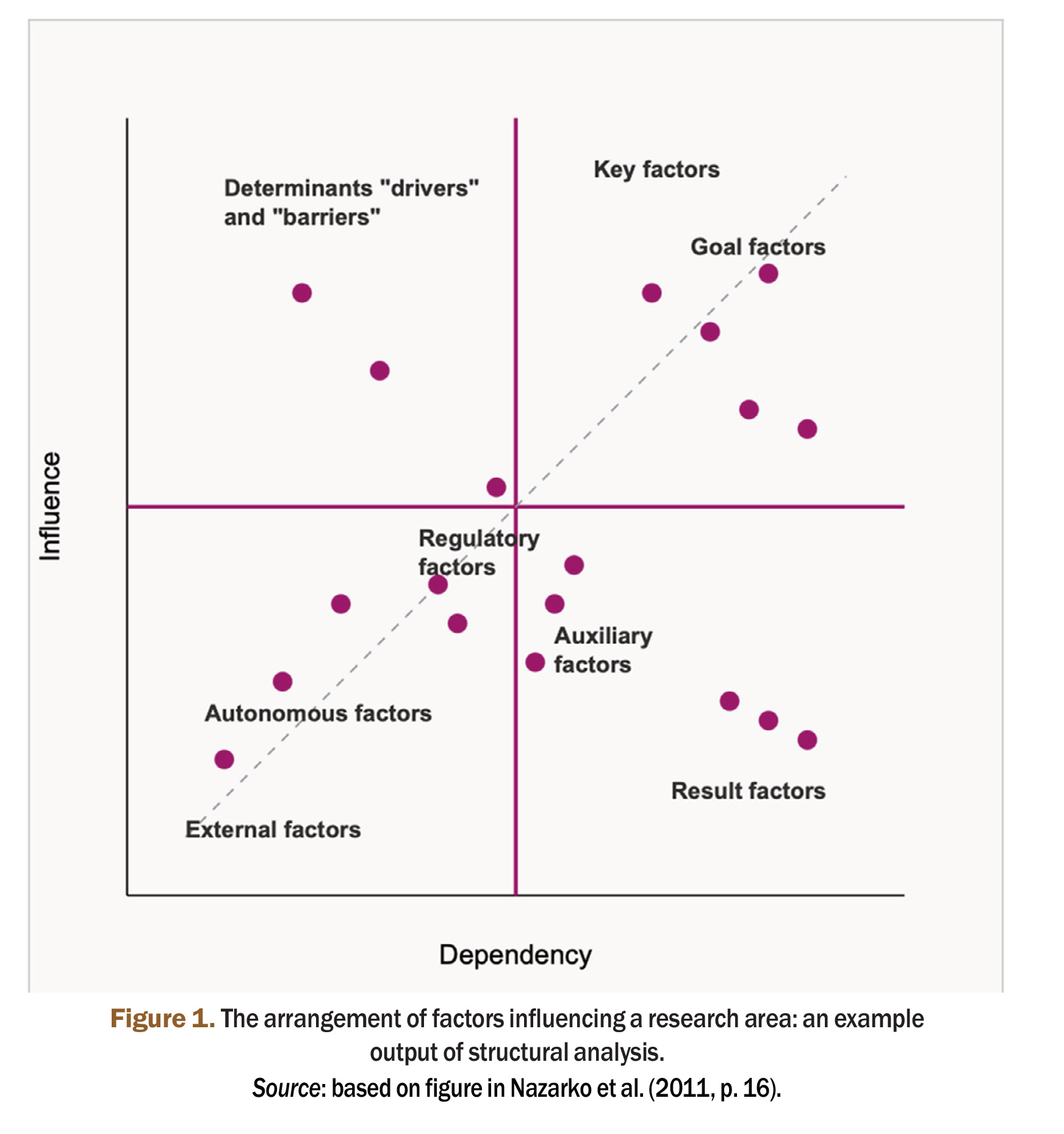
The use of structural analysis in the research process followed an established procedure, which is graphically presented in Figure 2.
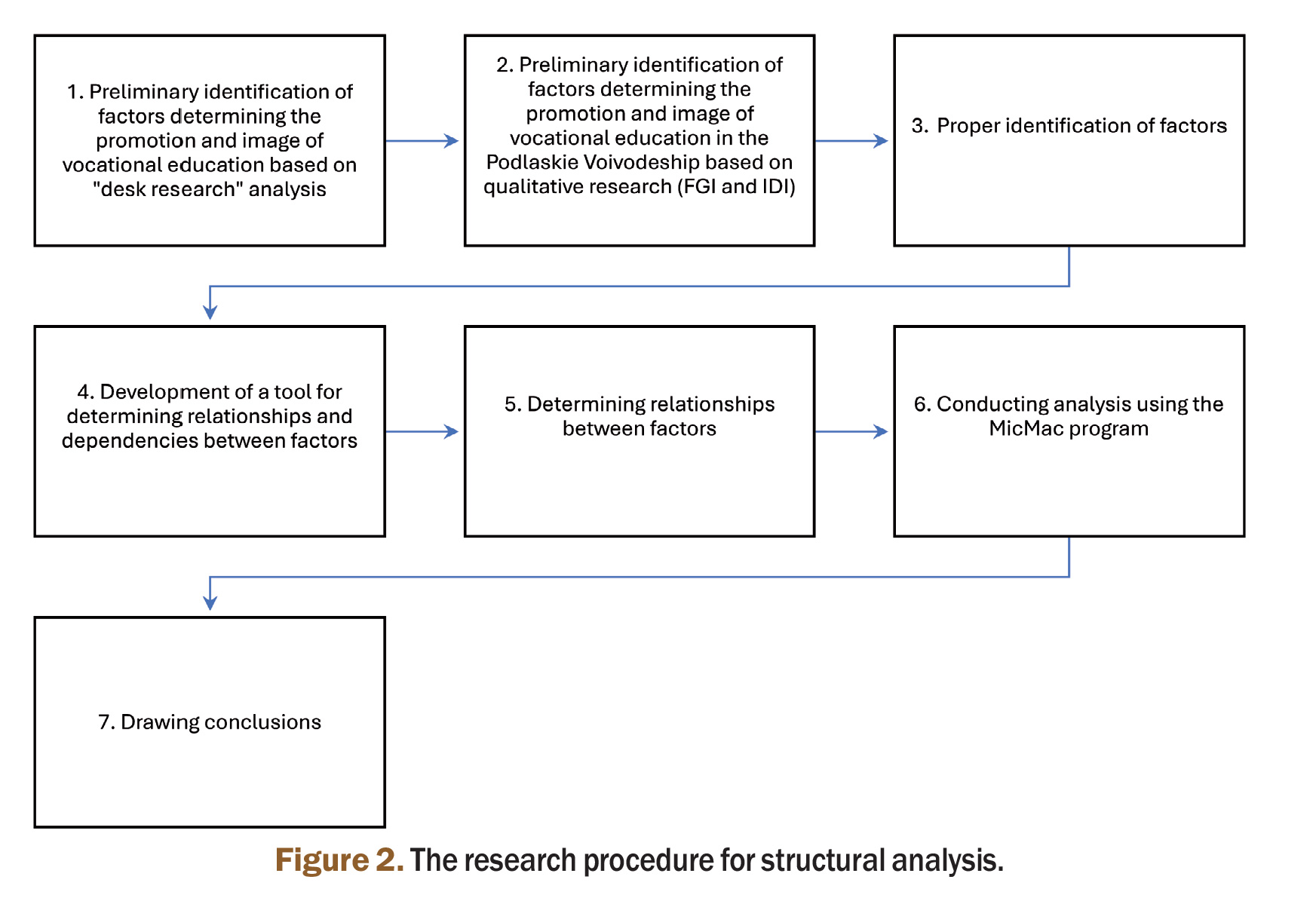
An important step in structural analysis is to identify factors that genuinely determine the phenomenon under investigation. In the first phase, a “desk research” analysis was conducted (Figure 2), involving a critical review of the literature on educational marketing and studies on vocational education (at both national and regional levels). Based on this review, an initial list of factors was created. This list was subsequently refined based on expert suggestions gathered during the FGI (Focus Group Interview) process. For the purposes of this study, experts were defined as representatives of organizations and institutions with unquestionable knowledge in vocational education, as well as practitioners and researchers specializing in the studied area. As a result, a comprehensive list of factors was drawn up (Table 1), which served as a tool for determining relationships and interdependencies among the identified factors.
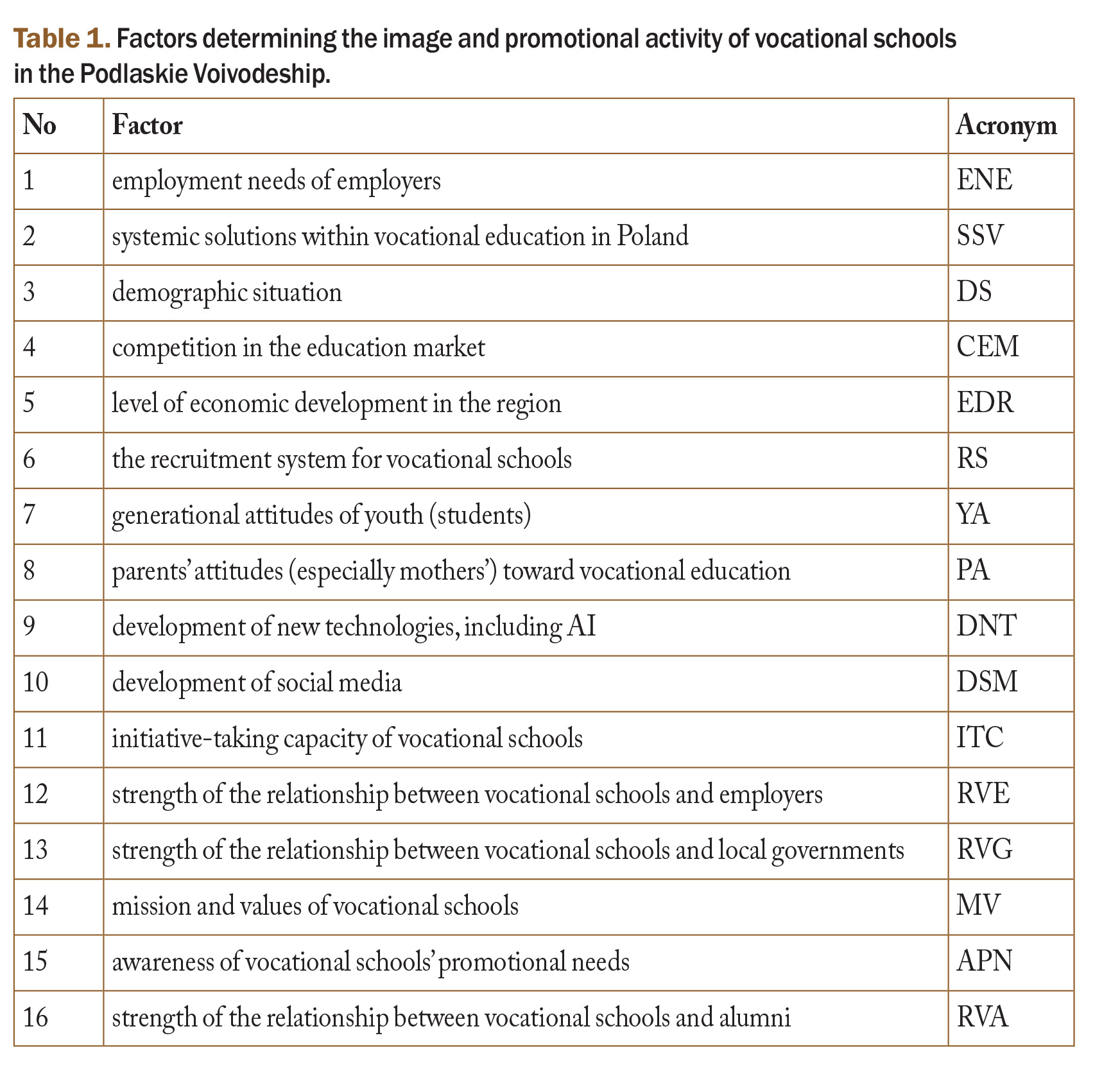
The arrangement of factors influencing the analyzed research area was developed using a structural analysis matrix (Table 2). In this matrix, 10 experts evaluated the impact of the individual factors on one another on a scale from 0 to 3, where:
- 0 indicated no influence,
- 1 indicated weak influence,
- 2 indicated moderate influence, and
- 3 indicated strong influence.
Their assessments provided the foundation for building the structural analysis matrix presented below. All factors were next analyzed to explore their relationships and interconnections, which collectively define the system.
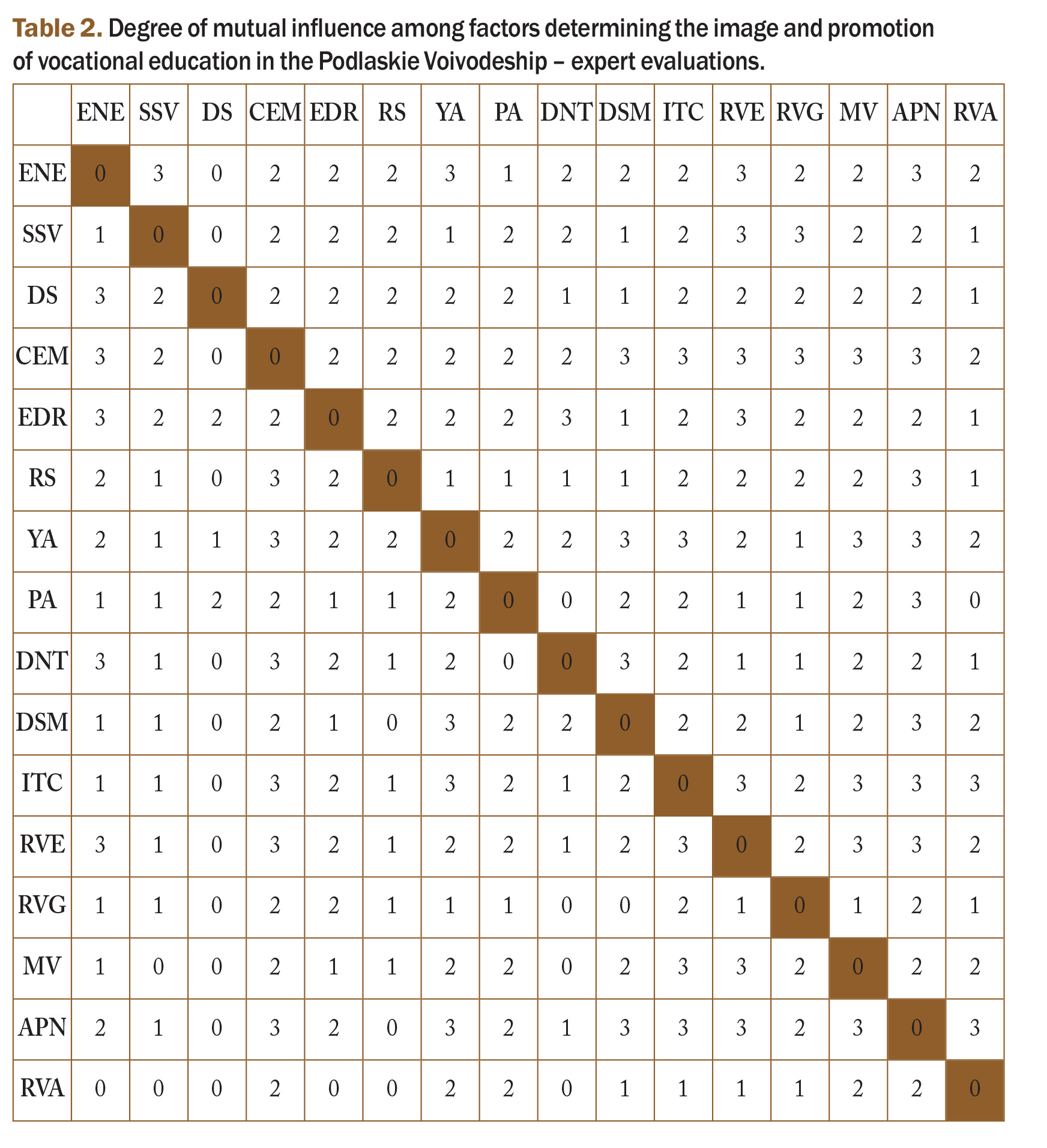
The experts participating in the study identified 214 relationships among the factors (variables), indicating 42 instances of zero, which represented a lack of relationship between variables. Weak relationships (rated as 1) were identified 58 times, while 106 instances were rated as moderate (2). Strong relationships (3) between variables occurred in 50 cases. Non-zero values were recorded in 84% of the fields in the matrix (Table 3).
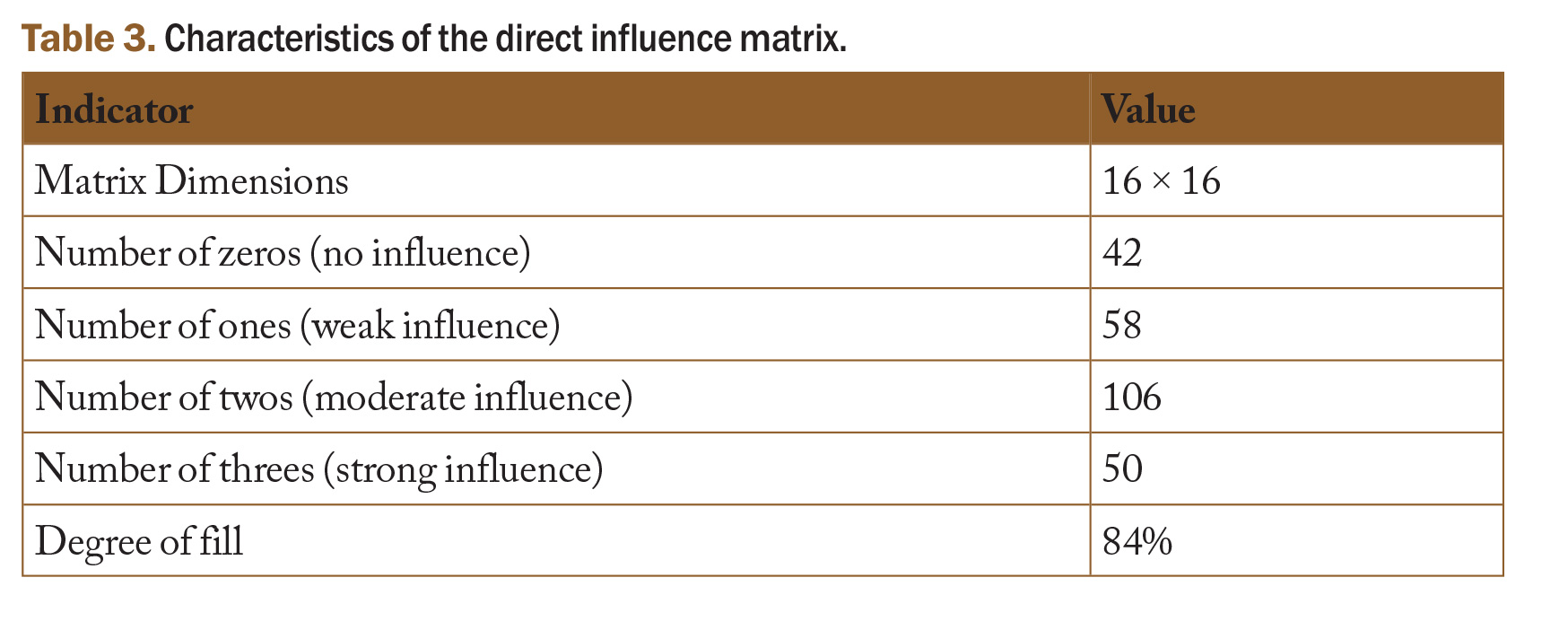
4. Analysis of research results
Analyzing the summary results of calculations regarding the strengths and direct dependencies (Table 4) revealed the following trends:
- The factors exerting a strong direct influence on others were as follows: competition in the education market (CEM), generational attitudes of youth (students) (YA) level of economic development in the region (EDR), awareness of vocational schools’ promotional needs (APN), the strength of the relationship between vocational schools and employers (RVE) the initiative-taking capacity of vocational schools (ability to undertake initiatives) (ITC).
- The factors most dependent on others were as follows: awareness of vocational schools’ promotional needs (APN), competition in the education market (CEM), the initiative-taking capacity of vocational schools (ITC), the mission and values of vocational schools (MV), the strength of the relationship between vocational schools and employers (RVE).
- The factor with the least dependency on others was the demographic situation (DS). Other factors with relatively low dependency include: the recruitment system for vocational schools (RS), systemic solutions within vocational education in Poland (SSV), and the development of new technologies, including AI (DNT).
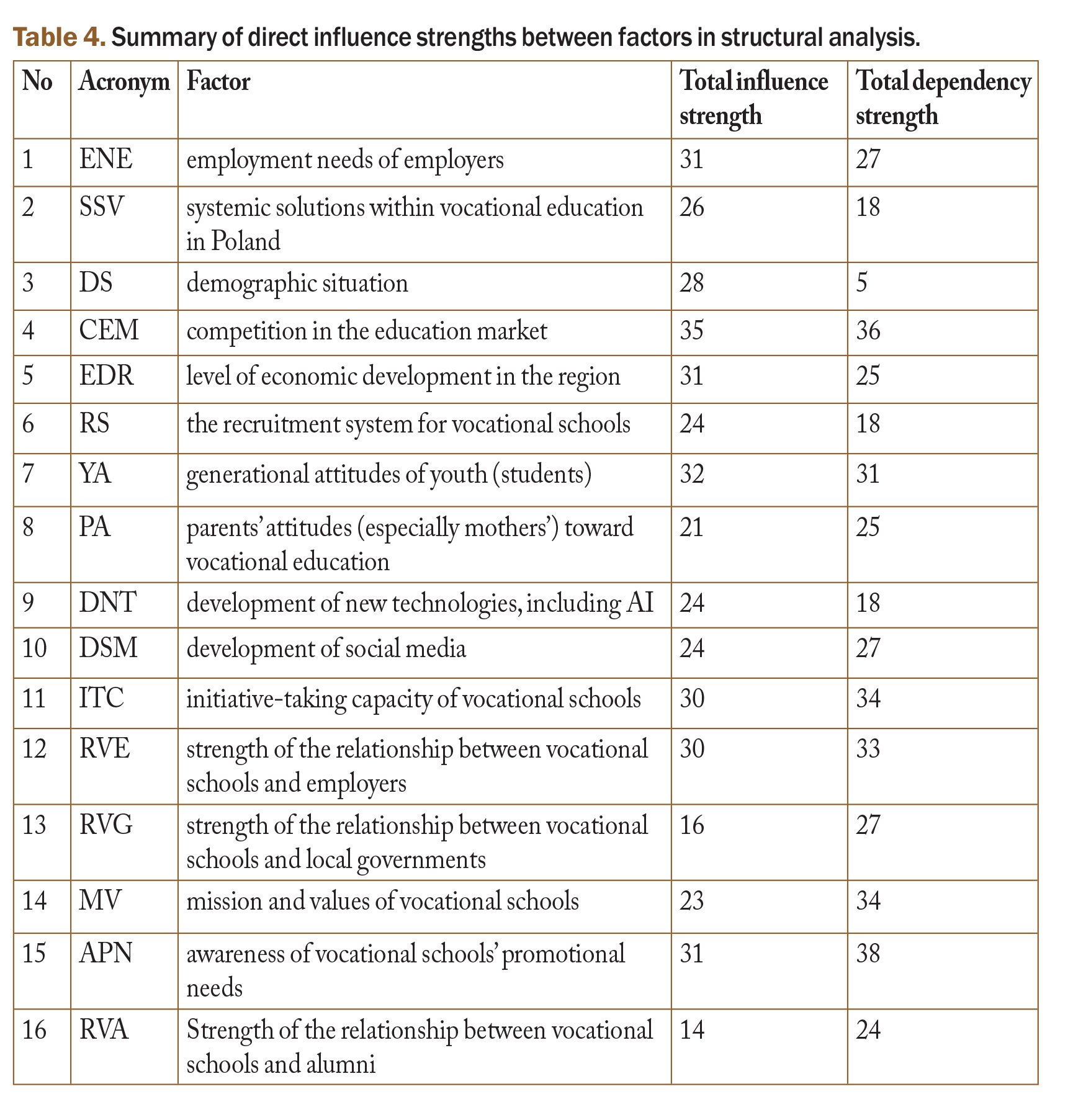
Based on the above, a graph was created using the Mic-Mac software, illustrating the strong direct influences of factors within the established system (Figure 3). Analysis of the graph reveals that the factors exhibiting the strongest connections are: awareness of vocational schools’ promotional needs (APN), strength of the relationship between vocational schools and employers (RVE), the initiative-taking capacity of vocational schools (ITC), competition in the education market (CEM), the generational attitudes of youth (students) (YA), and the employment needs of employers (ENE).
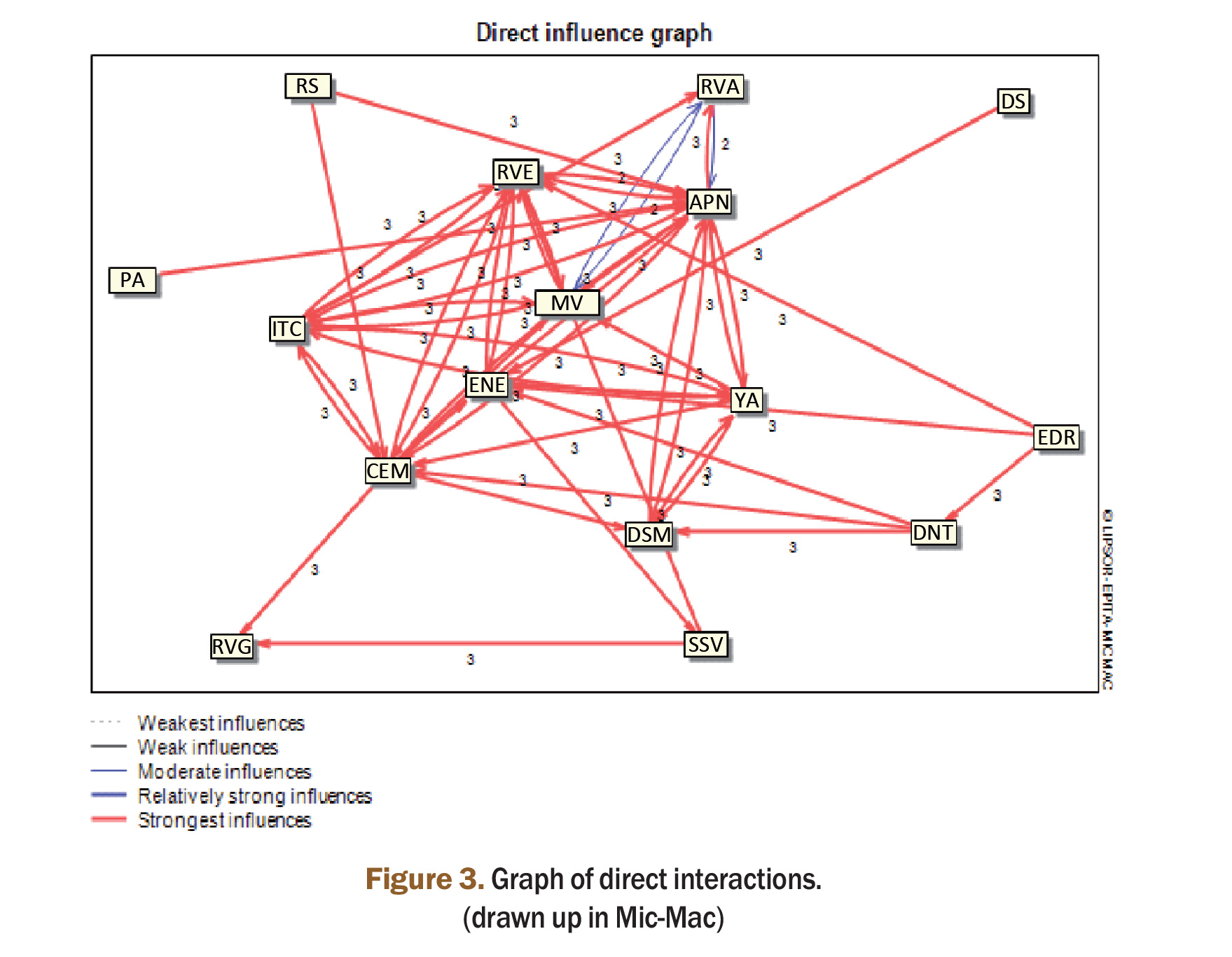
Based on the graph of direct interactions, strong connections can be observed between the following factors:
- The strength of the relationship between vocational schools and employers (RVE) and the employment needs of employers (ENE);
- Competition in the education market (CEM) and the initiative-taking capacity of vocational schools (ITC);
- Awareness of vocational schools’ promotional needs (APN) and the development of social media (DSM);
- The initiative-taking capacity of vocational schools (ITC) and the strength of the relationship between vocational schools and employers (RVE);
- The strength of the relationship between vocational schools and employers (RVE) and the mission and values of vocational schools (MV);
- The initiative-taking capacity of vocational schools (ITC) and the strength of the relationship between vocational schools and alumni (RVA).
The observed interactions underscore the need for vocational schools to adopt a pragmatic approach to promotion, which also includes a rational dimension aimed at increasing recruitment and enhancing school recognition. Relationships with employers are likely to intensify, especially in cases where there is a heightened demand for education in specific fields or professions. The strong competition emerging among schools necessitates greater efforts to attract students, which in turn strengthens the need for closer relationships with employers. Vocational schools that demonstrate initiative are also more likely to reinforce relationships with alumni, who, as stakeholders, can disseminate positive opinions about the school and share their favorable educational experiences. The analysis performed in Mic-Mac further confirms that employers influence the shaping of a school’s mission and values. This is logical, as they form the core and foundation of vocational education. The identity of a vocational school is built on its relationships with employers, who play a pivotal role in defining the school’s direction and priorities.
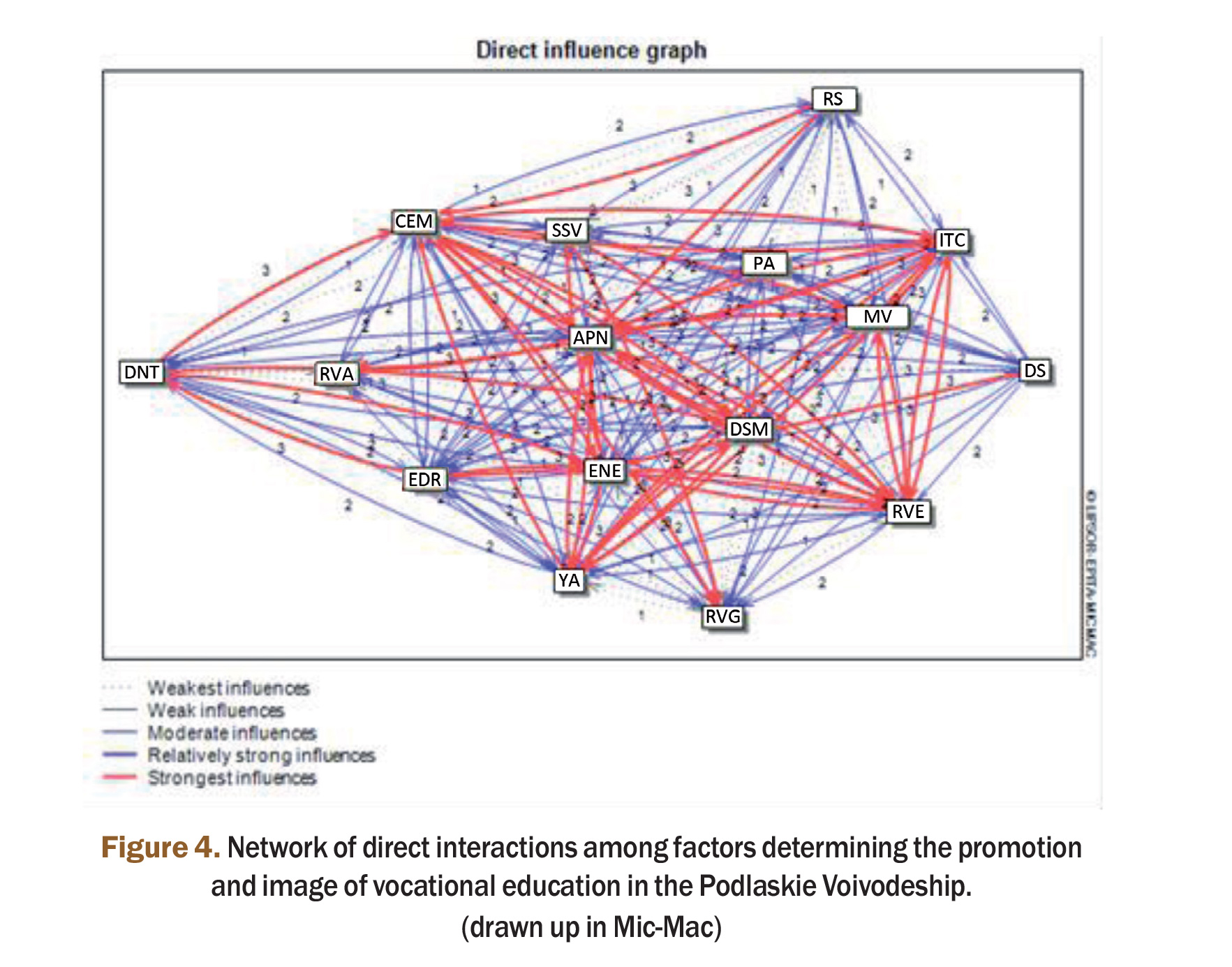
Moreover, the performed in Mic-Mac demonstrates that the shaping of the image and promotion of vocational education is influenced by multiple factors, among which numerous interactions can be observed (Figure 4). This confirms that promotional activities and image-building efforts for vocational schools require consideration of a broad context. This involves focusing on the internal potential of the school while simultaneously leveraging relationships established with external stakeholders, primarily employers but also alumni. The analysis also highlights the strategic dimension of vocational education promotion, emphasizing the importance of integrating internal strengths with external collaborations to achieve long-term goals and enhance the school’s competitive position.
Key factors combine a strong influence with a high level of dependency (Nazarko et al., 2011). In the context of promoting vocational education, several key factors can be identified, which can be categorized into external and internal factors. The Key External Factors are competition in the education market (CEM), generational attitudes of youth (students) (YA), employment needs of employers (ENE), the level of economic development in the region (EDR). The Key Internal Factors, in turn, are awareness of vocational schools’ promotional needs (APN), initiative-taking capacity of vocational schools (ITC), strength of relationships between vocational schools and employers (RVE). This demonstrates that a school’s activities aimed at attracting new students and solidifying its desired image among stakeholders require addressing multiple perspectives, which poses certain challenges.
The effectiveness of vocational education promotion is influenced by the economic development of the region, which drives the growth of enterprises that express demand for specific professions. Economic development enhances the perception of vocational education among key stakeholder groups, thereby strengthening its position within the socio-economic environment.
While external factors play a significant role, internal factors are equally crucial. Vocational schools must consistently demonstrate initiative and maintain an awareness of their promotional needs, regardless of external circumstances. The effectiveness of their promotional activities heavily depends on the strength of their relationships with employers, who form the core of the school’s relational capital.
The promotional activities of vocational schools, much like those of commercial entities, are grounded in knowledge about their target audience. Therefore, understanding the generational attitudes of youth is vital for shaping effective promotional strategies and achieving success in a competitive educational landscape.
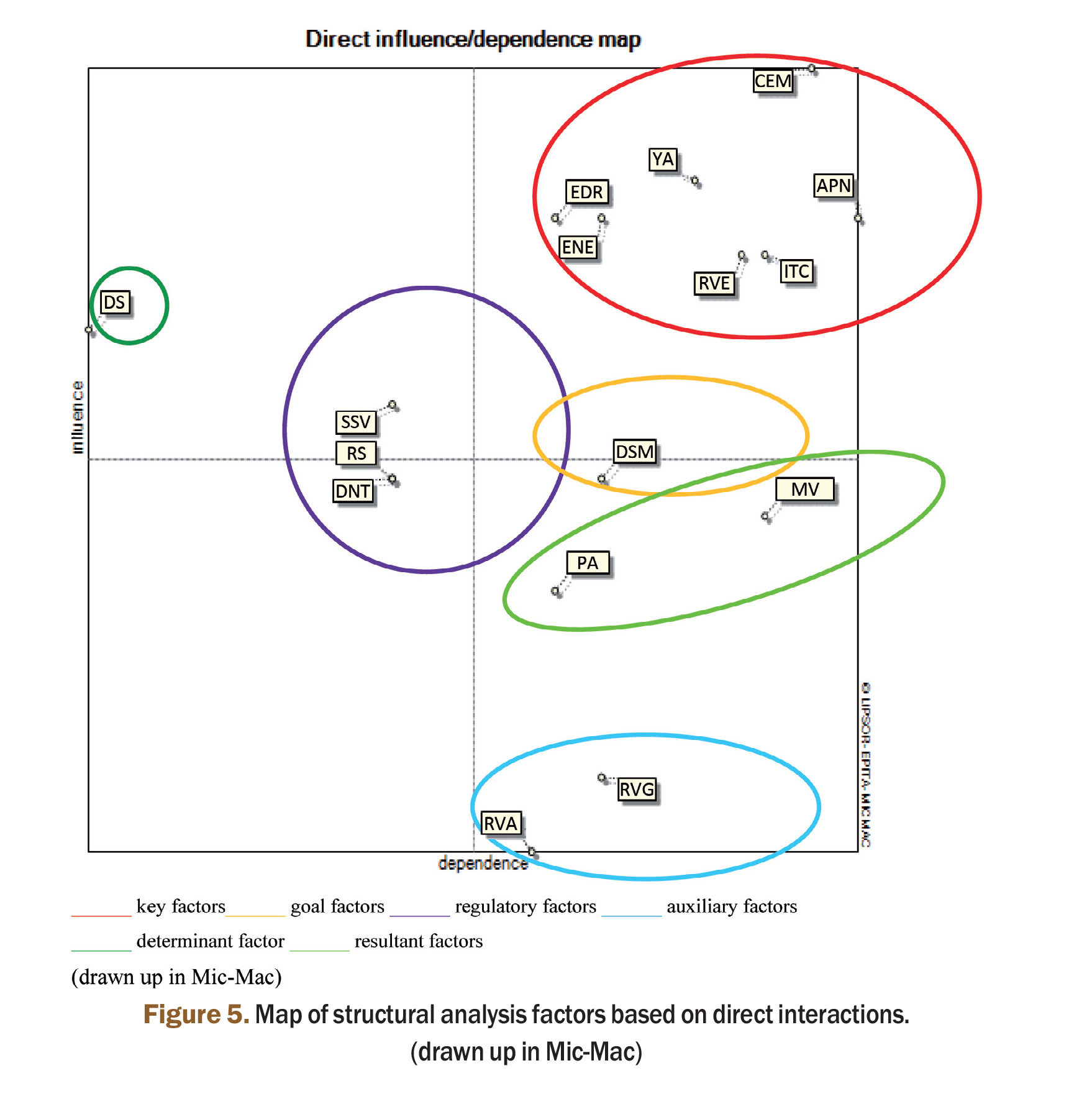
Goal factors are those that are more influenced by other factors than they influence the remaining ones; they represent potential objectives within the studied system. In the system of factors determining the promotion and image of vocational education, the factor “development of social media“ (DSM) was found to serve this role. As a phenomenon within the broader sphere of communication, the development of social media is subject to continuous evolution. A noticeable trend is the segmentation of these media based on generational needs. Communication within the educational sector must account for changes occurring in social media; however, it is not a determinant of their development.
This underscores the adaptive role vocational schools must play, aligning their communication strategies with the evolving nature of social media to effectively reach their target audiences.
Dependent/resultant factors are characterized by low influence and high dependency on other factors. They are particularly susceptible to changes driven by decisive and key factors. The following have been identified as resultant factors: parents’ attitudes (especially mothers’) toward vocational education (PA) and mission and values of vocational schools (MV). The analysis indicates that parents’ attitudes toward vocational schools are a result of interdependencies among key factors. The desired behavior of parents, who often co-decide on their child’s educational path, will be influenced, among other things, by the economic situation, including labor market conditions, and by the initiative of the school in actively seeking their attention. Vocational schools should clearly communicate their mission and values, ensuring they align with changes in the socio-economic environment of the school. A failure to define an attractive and coherent value system, relevant from the perspective of various stakeholder groups, including current and potential students, diminishes the credibility of promotional efforts and weakens the image of the educational institution.
Decisive factors (determinants) are those that exert a very strong influence on the system, acting as either “drivers“ or “barriers,“ but are difficult to control. The map of direct interactions (Chart 3) indicates that in the system of factors, the demographic situation (DS) factor has been found to fulfil this role. The state of vocational education depends significantly on demographic trends. Unfavorable tendencies in this area amplify the role of promotion as a tool to support recruitment processes and increase competition among vocational schools. They also emphasize the need to focus on image-building and creating a distinctive educational offering.
Regulatory/auxiliary factors are characterized by a low level of influence on the system but can be helpful in achieving strategic goals. In the analyzed system, these include: systemic solutions within vocational education in Poland (SSV), the recruitment system for vocational schools (RS), the development of new technologies, including AI (DNT). Vocational schools operate within frameworks that are often imposed from above, such as recruitment systems and regulations derived from the structure of vocational education in Poland. These factors significantly shape the activities of vocational schools, including their promotional efforts. The development of new technologies and artificial intelligence (AI) plays a dual role within the system. On the one hand, it can contribute to creating more engaging and attractive communication strategies. On the other hand, it serves as a distinguishing feature for schools, showcasing their commitment to innovation and modernity.
Resultant factors are characterized by low influence and high dependency on other factors, making them particularly susceptible to changes driven by decisive and key factors. Within the system of factors determining the promotion and image of vocational education, the identified resultant factors include: parents’ attitudes (especially mothers’) toward vocational education (PA), mission and values of vocational schools (MV). The first determinant – parents’ attitudes, particularly mothers’ – indicates that parental decisions may stem from the general labor market situation and an evaluation of vocational education as a component of the broader Polish educational system. The mission and values of vocational schools should remain current and comprehensible for all stakeholder groups. They must also reflect transformations in generational attitudes among young people to maintain relevance.
Note that no autonomous factors – those with the least influence on and from other factors – were identified within the system. This absence confirms the high level of dynamism and the complexity of interactions among the determinants in the system. This dynamic nature underscores the interconnectedness and interdependence of factors shaping the promotion and image of vocational education.
5. Conclusions
The structural analysis identified six types of factors determining the promotion and image of vocational education (Figure 3):
1. Key Factors:
- Competition in the education market (CEM);
- Generational attitudes of youth (students) (YA);
- Awareness of vocational schools’ promotional needs (APN);
- Initiative-taking capacity of vocational schools (ITC);
- Strength of the relationship between vocational schools and employers (RVE);
- Employment needs of employers (ENE);
- Level of economic development in the region (EDR).
2. Goal Factor:
- Development of social media (DSM).
Social media platforms have become integral to communication with students, parents, and employers, providing vocational schools with tools to engage stakeholders effectively.
However, success depends on the ability to adapt communication strategies to evolving trends and generational preferences.
3. Resultant Factors:
- Parents’ attitudes (especially mothers’) toward vocational education (PA);
- Mission and values of vocational schools (MV).
Positive parental perceptions and well-defined institutional missions are critical for building credibility and trust. Vocational schools must ensure their values align with stakeholder expectations and labor market demands to improve their image and appeal.
4. Regulatory Factors:
- Systemic solutions within vocational education in Poland (SSV);
- The recruitment system for vocational schools (RS);
- Development of new technologies, including AI (DNT).
While these factors offer limited direct influence, they provide essential conditions for growth and innovation. Strategic use of technology, particularly AI, can differentiate schools and enhance the attractiveness of vocational education.
5. Auxiliary Factors:
- Strength of the relationship between vocational schools and alumni (RVA);
- Strength of the relationship between vocational schools and local governments (RVG).
Alumni networks can serve as ambassadors, promoting the school’s reputation, while cooperation with local governments ensures alignment with regional development strategies and resource access.
6. Determinant Factor:
- Demographic situation (DS).
Declining student populations increase competition among schools, intensifying the need for effective promotion and image-building strategies to attract candidates and address workforce gaps.
This categorization highlights the dynamic and multifaceted nature of the factors shaping the promotion and image of vocational education. Each category plays a distinct role, ranging from driving strategic actions to supporting and regulating efforts within the system. This highlights the necessity of implementing a strategic approach in promotional efforts rather than focusing solely on previously adopted activities. The interdependencies within the system are highly dynamic, emphasizing that schools, like businesses, should conduct in-depth analyses of their environment. In the constructed system, a greater number of factors determining vocational schools’ promotion are external.
The reliance on expert evaluations ensured that the findings are grounded in practical and professional perspectives, offering valuable insights for both policymakers and vocational education practitioners.
Key recommendations emerging from these findings are as follows:
- Vocational schools need to strengthen their relational capital. This involves enhancing their expertise in building relationships not only with students but also with employers and local governments.
- The initiative-taking capacity of vocational schools has a significant impact on other factors, indicating its pivotal role. Schools should begin by consciously defining and then clearly communicating their values, as these can positively shape their image and distinguish them from competitors.
- The process of building the mission of a vocational school, grounded in these values, should involve active participation from representatives of employers and local governments who collaborate with vocational schools. This approach ensures alignment with stakeholder expectations and reinforces the school’s role within its community
References
Al-Malood, F., & Pretorius F.J. (2006), Marketing Strategies in a Vocational Program. Mt. San Antonio College & University of South Africa, 1–9.
Billett, S. (2011). Vocational Education Purposes, Traditions and Prospects. Springer, 135–174.
Colan, G., Tincuta, V., & Raducan, M. (2019). Marketing Mix Approaches in Educational Services and Public Administration. International Conference “Risk in Contemporary Economy”, “Dunarea de Jos” University of Galati, Faculty of Economics and Business Administration, 361–377. https://doi.org/10.35219/rce2067053242
Glava, C. C., & Glava, A. E. (2015). Moment of Truth in Educational Marketing: Factors That Contribute to the Decision Making on the Educational Market in Romania. Procedia – Social and Behavioral Sciences, 180(5), 170–175. https://doi.org/10.1016/j.sbspro.2015.02.101
Gulc, A.M. (2020). Relacyjny model kształtowania jakości usług kurierskich w branży e-commerce [A relational model for shaping the quality of courier services in the e-commerce industry]. Oficyna Wydawnicza Politechniki Białostockiej.
Hajduk-Stelmachowicz, M. (2019), Promocja szkoły w środowisku jako kompetencja kierownicza w zakresie organizacji i zarządzania oświatą [School promotion in the community as a managerial competence in education organization and management]. Przedsiębiorczość – Edukacja, 15(1), 91–92. https://doi.org/10.24917/20833296.151.7
Hall, H. (2007). Marketing w szkolnictwie [Marketing in education]. Wolters Kluwer Polska.
Krzyżak, M. (2000), Działania promocyjne szkół i uczelni [Promotional activities of schools and universities]. Marketing i Rynek, 12, 17.
Kongres Przedsiębiorczości (2011). Diagnozy i rekomendacje kongresu przedsiębiorczości w sprawie szkolnictwa zawodowego [Diagnoses and recommendations of the Congress of Entrepreneurship regarding vocational education]. Kongres Przedsiębiorczości, 3–6.
Kumar, P., & Kaur, S. (2022). Educational Marketing: An Empirical Analysis of Promotional Tools Considered by Private Universities in Punjab. International Journal of Academic Research & Development (IJAR&D), 8(2), 11–14.
Kwaśniewski, J.P., & Kęsy, M. (2022). Zarządzanie kompetencjami a edukacja zawodowa [Competence management and vocational education]. In M. Kęsy, Ł. Moniuszko (Eds.), Kompetencje menedżera (pp. 95‒110). Wydawnictwo Uczelniane Wyższej Szkoły Gospodarki.
Lis, M., & Miazga, A. (2016). Ocena jakości polskiego systemu kształcenia zawodowego z perspektywy potrzeb rynku pracy [Evaluation of the quality of the Polish vocational education system from the perspective of labor market needs]. Edukacja, 1(136).
Manea, N., & Purcaru, M. (2017). The Evolution of Educational Marketing. Annals of Spiru Haret University, Economic Series, 17(4). https://doi.org/10.26458/1744
Nazarko, J. Ejdys, J., Kononiuk, A., & Olszewska, A. (2013). Analiza strukturalna jako metoda klasyfikacji danych w badaniach foresight [Structural analysis as a data classification method in foresight research]. Prace Naukowe UE we Wrocławiu, 278, 44–52.
Nazarko, J., Wnorowski, H., & Kononiuk, A. (2011). Analiza strukturalna czynników rozwoju nanotechnologii w województwie podlaskim [Structural analysis of nanotechnology development factors in the Podlaskie Voivodeship]. Oficyna Wydawnicza Politechniki Białostockiej.
Pimpa, N., & Suwannapirom, S. (2008). Thai students’ choices of vocational education: marketing factors and reference groups. Educational Research Policy and Practice, 7, 99–107.
Rachwał, T. (2019). Przedsiębiorczość jako kompetencja kluczowa w systemie edukacji [Entrepreneurship as a key competence in the education system]. In T. Rachwał (Ed.), Kształtowanie kompetencji przedsiębiorczych, FRSE Warszawa.
Rauer, F. (2008), Handbook of Technical and Vocational Education and Training Research. International Centre for Education, Germany.
Samujło, M., & Samujło, B. (2014). Wykształcenie zawodowe – miejsce w systemie edukacji i na rynku pracy. Kształcenie zawodowe – oczekiwania i potrzeby [Vocational education – its place in the education system and labor market. Vocational education – expectations and needs]. Edukacja – Technika – Informatyka, 5(1), 180–185.
Stasiak, J. (2011), System edukacji wobec wyzwań rynku pracy w Polsce [The education system in response to labor market challenges in Poland]. Acta Universitatis Lodziensis Folia Oeconomica, 248, 344–357.
Sztanderska, U., & Grotkowska, G. (2019) Wykształcenie zawodowe – miejsce w systemie edukacji i na rynku pracy [Vocational education – its place in the education system and labor market]. In U. Sztanderska, E. Drogosz-Zabłocka (Eds.), Wykształcenie zawodowe Perspektywa systemu edukacji i rynku pracy (pp. 25–65). Wydawnictwo FRSE.
Szymańska, E. (2008). Współuczestnictwo rodziców w procesie edukacyjnym dziecka [Parental participation in the child’s educational process]. Kultura i Edukacja, 1, 155–175.
Wasilewska, O., & Matuszczak, K. (2019), Kształcenie i szkolenie zawodowe w Polsce – w pigułce [Vocational education and training in Poland – an overview]. Instytut Badań Edukacyjnych. Cedefop ReferNet.
Wierenko, T. (2015). Wybrane instrumenty zarządzania promocją szkoły wyższej [Selected instruments for managing university promotion]. Zeszyty Naukowe ZPSB Firma i Rynek, 1(48), 105–116.
Witczak, O. (2013), Nowe media w budowaniu marki i wizerunku przedsiębiorstwa [New media in building brand and company image]. Studia Ekonomiczne, 140, 82.
Włodarczyk, E., & Ziarko, A. (2017). Działania szkół i nauczycieli na rzecz poprawy jakości procesu kształcenia. Intencje i rzeczywistość [Actions of schools and teachers to improve the quality of the teaching process: Intentions and reality]. In I. Ocetkiewicz (Ed.), Szkoła jako organizacja ucząca się? Perspektywa ewaluacji zewnętrznej (pp. 53–82). UP Kraków.
Wójcicki, J. M., & Ładyżyński, P. (Eds.) (2008), System monitorowania i scenariusze rozwoju technologii medycznych w Polsce [Monitoring system and development scenarios for medical technologies in Poland], Konsorcjum ROTMED.
Wu, J., & Liang, Y. (2023). Empowering Vocational Education New Media Marketing Teaching Reform and Practical Exploration with AIGC. Journal of Education and Educational Research, 6(2), 82–85. https://doi.org/10.54097/jeer.v6i2.14965
Yang, X. (2016). Education Marketing Research. Theoretical Economics Letters, 6, 1180–1185. https://doi.org/10.4236/tel.2016.65111
Zieliński, P., Grudowski, P., & Szymańska-Brałkowska, M. (2014). Oczekiwania interesariuszy usług edukacyjnych w ujęciu relacyjnym [Stakeholder expectations of educational services in relational terms]. Prace Naukowe Uniwersytetu Ekonomicznego we Wrocławiu, 353, 175–183.
Zupok, S. (2018). Wartość dla klienta a cele organizacji [Customer value and organizational goals]. Studia i Prace WNEIZ US, 5, 81–83. https://doi.org/10.18276/SIP.2018.53/3-07
Żebrok, P. (2015), Marketing w publicznych placówkach oświatowych [Marketing in public educational institutions]. Edukacja Humanistyczna, 2(33), 107–121.
Żegnałek, K., & Gutkowska-Wyrzykowska, E. (2016). Nauczyciel – misja czy zawód? [Teacher – a mission or a profession?]. Zeszyty Naukowe Wyższej Szkoły Humanitas, Pedagogika, 13, 173–184.
Urszula Widelska – Ph.D. in economics, professor at the University of Lomza, and Deputy Head of the Department of Economics and Finance. Author of numerous publications, primarily in the field of relationship marketing and customer orientation. Project leader and expert in numerous research projects, including a grant from the National Science Centre.

